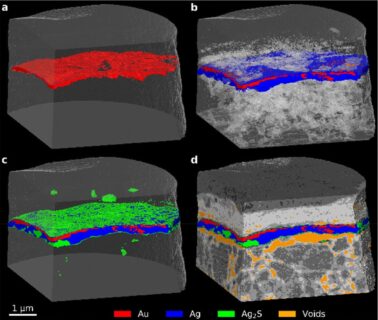June 2024

Zwischgold is an ultra-thin bilayer metal leaf that has been developed in medieval times as an alternative to gold leaves. It consists of a Au top-layer on Ag leaf. While it had been believed for a long time that zwischgold was a cheap mock of real leaf gold, it is more likely that it was often used intentionally for its more pale hue. E.g., zwischgold may separate saints from the holy family covered in more intense leaf gold.
Zwischgold, however, has one major disadvantage. Over time it turns black. This decomposition is caused by a slow diffusion of Ag through the Au film and subsequent corrosion towards Ag2S and AgCl. This is a delicate challenge for modern curators. Andreas Späth and Rainer Fink (Physical Chemistry II) have contributed to an in-depth study of diffusion and corrosion in zwischgold layers employing correlative microscopy and spectroscopy techniques. The study was lead by Qing Wu (Haute École Arc, Neuchâtel) and Ben Watts (Paul Scherrer Institute, Villigen).
The kalender figure shows a 3D reconstruction of ptychographic X-ray CT of the coating of a medieval altar figure („Mary“, Leiggern Altar, 1420, now at Swiss National Museum, Zurich). In this case Ag and ist corrosion products are found below and on top of Au. The figure had been covered with resin to slow down corrosion.
The study helps to develop better conservation techniques for bilayer leaf coated artwork.
Original Publication: Wu et al., Nanoscale, 2022, 14, 15165 – 15180
https://doi.org/10.1039/D2NR03367D
Link to Research Group:
